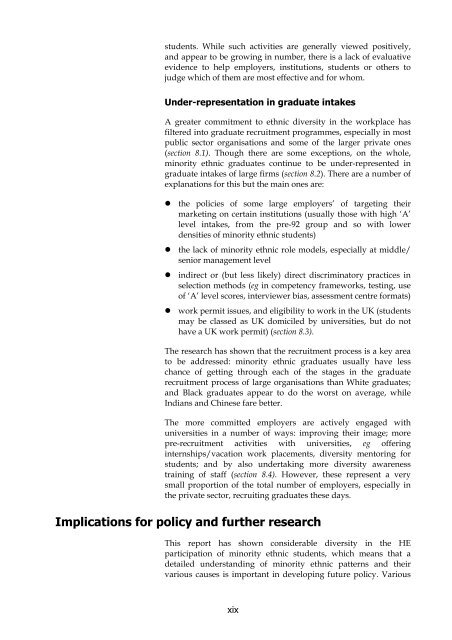A Closer Look at Higher Education Minority Ethnic Students and ...
A Closer Look at Higher Education Minority Ethnic Students and ...
A Closer Look at Higher Education Minority Ethnic Students and ...
Create successful ePaper yourself
Turn your PDF publications into a flip-book with our unique Google optimized e-Paper software.
students. While such activities are generally viewed positively,<strong>and</strong> appear to be growing in number, there is a lack of evalu<strong>at</strong>iveevidence to help employers, institutions, students or others tojudge which of them are most effective <strong>and</strong> for whom.Under-represent<strong>at</strong>ion in gradu<strong>at</strong>e intakesA gre<strong>at</strong>er commitment to ethnic diversity in the workplace hasfiltered into gradu<strong>at</strong>e recruitment programmes, especially in mostpublic sector organis<strong>at</strong>ions <strong>and</strong> some of the larger priv<strong>at</strong>e ones(section 8.1). Though there are some exceptions, on the whole,minority ethnic gradu<strong>at</strong>es continue to be under-represented ingradu<strong>at</strong>e intakes of large firms (section 8.2). There are a number ofexplan<strong>at</strong>ions for this but the main ones are:• the policies of some large employers’ of targeting theirmarketing on certain institutions (usually those with high ‘A’level intakes, from the pre-92 group <strong>and</strong> so with lowerdensities of minority ethnic students)• the lack of minority ethnic role models, especially <strong>at</strong> middle/senior management level• indirect or (but less likely) direct discrimin<strong>at</strong>ory practices inselection methods (eg in competency frameworks, testing, useof ‘A’ level scores, interviewer bias, assessment centre form<strong>at</strong>s)• work permit issues, <strong>and</strong> eligibility to work in the UK (studentsmay be classed as UK domiciled by universities, but do nothave a UK work permit) (section 8.3).The research has shown th<strong>at</strong> the recruitment process is a key are<strong>at</strong>o be addressed: minority ethnic gradu<strong>at</strong>es usually have lesschance of getting through each of the stages in the gradu<strong>at</strong>erecruitment process of large organis<strong>at</strong>ions than White gradu<strong>at</strong>es;<strong>and</strong> Black gradu<strong>at</strong>es appear to do the worst on average, whileIndians <strong>and</strong> Chinese fare better.The more committed employers are actively engaged withuniversities in a number of ways: improving their image; morepre-recruitment activities with universities, eg offeringinternships/vac<strong>at</strong>ion work placements, diversity mentoring forstudents; <strong>and</strong> by also undertaking more diversity awarenesstraining of staff (section 8.4). However, these represent a verysmall proportion of the total number of employers, especially inthe priv<strong>at</strong>e sector, recruiting gradu<strong>at</strong>es these days.Implic<strong>at</strong>ions for policy <strong>and</strong> further researchThis report has shown considerable diversity in the HEparticip<strong>at</strong>ion of minority ethnic students, which means th<strong>at</strong> adetailed underst<strong>and</strong>ing of minority ethnic p<strong>at</strong>terns <strong>and</strong> theirvarious causes is important in developing future policy. Variousxix
















